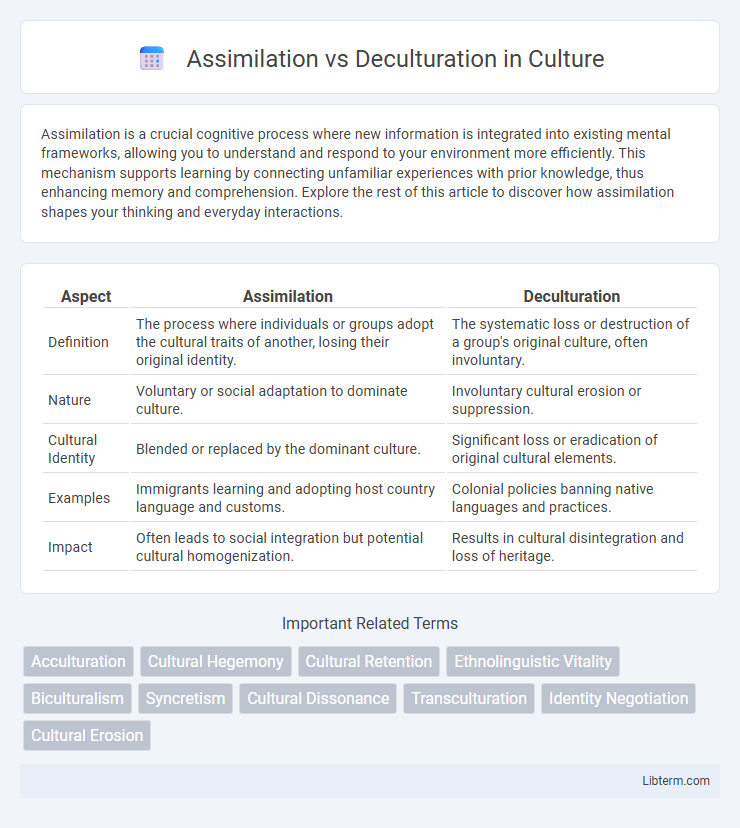Assimilation is a crucial cognitive process where new information is integrated into existing mental frameworks, allowing you to understand and respond to your environment more efficiently. This mechanism supports learning by connecting unfamiliar experiences with prior knowledge, thus enhancing memory and comprehension. Explore the rest of this article to discover how assimilation shapes your thinking and everyday interactions.
Table of Comparison
| Aspect | Assimilation | Deculturation |
|---|---|---|
| Definition | The process where individuals or groups adopt the cultural traits of another, losing their original identity. | The systematic loss or destruction of a group's original culture, often involuntary. |
| Nature | Voluntary or social adaptation to dominate culture. | Involuntary cultural erosion or suppression. |
| Cultural Identity | Blended or replaced by the dominant culture. | Significant loss or eradication of original cultural elements. |
| Examples | Immigrants learning and adopting host country language and customs. | Colonial policies banning native languages and practices. |
| Impact | Often leads to social integration but potential cultural homogenization. | Results in cultural disintegration and loss of heritage. |
Understanding Assimilation: Definition and Key Concepts
Assimilation involves the process by which individuals or groups adopt the cultural traits of another, often dominant, society, leading to the gradual loss of their original cultural identity. Key concepts include cultural absorption, social integration, and identity transformation, where the assimilated group blends into the dominant culture to achieve social acceptance. Understanding assimilation requires analyzing the balance between preserving original cultural elements and adapting to new social norms within multicultural settings.
What is Deculturation? Exploring Core Principles
Deculturation refers to the process by which individuals or groups lose their original cultural identity through exposure to a dominant culture, leading to the erosion of traditional beliefs, customs, and practices. This phenomenon often results from social, political, or economic pressures that compel assimilation while suppressing distinct cultural expressions. Core principles of deculturation include cultural displacement, identity transformation, and the weakening of ethnic heritage within multicultural societies.
Historical Perspectives on Assimilation and Deculturation
Historical perspectives on assimilation reveal its use as a policy to integrate minority groups into dominant cultures, often through education, language imposition, and social norms enforcement. Deculturation, contrastingly, refers to the forced loss or erosion of a group's cultural identity, frequently resulting from colonization, displacement, or systemic oppression. Both processes have shaped social dynamics and identity politics in societies worldwide, influencing contemporary debates on multiculturalism and cultural preservation.
Cultural Identity: How Assimilation Shapes Belonging
Assimilation transforms cultural identity by encouraging individuals to adopt the dominant society's customs, language, and values, often leading to a sense of belonging within that community. This process can result in the gradual erosion of original cultural traits, fostering social cohesion but risking the loss of unique heritage. In contrast, deculturation involves the complete removal or suppression of cultural elements, which may cause alienation and fragmented identity.
The Process and Stages of Deculturation
Deculturation is the process through which individuals or groups gradually lose their original cultural identity due to sustained exposure to a dominant culture. The stages of deculturation typically include contact, where initial interaction occurs; conflict, marked by cultural dissonance and resistance; and adjustment, when adaptation or assimilation to the new culture begins to overshadow indigenous practices and values. This process highlights the erosion of traditional customs, languages, and social behaviors as the dominant culture's norms become increasingly internalized.
Impacts of Assimilation on Minority Communities
Assimilation often leads to the erosion of cultural identity within minority communities, resulting in the loss of traditional languages, customs, and social practices. This process can diminish community cohesion and weaken intergenerational transmission of cultural knowledge. Such impacts contribute to diminished cultural diversity and may cause psychological stress related to identity conflicts among minority group members.
Psychological Effects of Deculturation
Deculturation often results in significant psychological effects, including identity confusion, low self-esteem, and increased stress due to the loss of familiar cultural frameworks. Individuals undergoing deculturation may experience a sense of alienation and disconnection from their heritage, leading to depression and anxiety. This cultural disintegration disrupts social support systems, exacerbating mental health challenges and hindering emotional resilience.
Assimilation vs. Deculturation: Key Differences and Similarities
Assimilation involves the process by which individuals or groups adopt the cultural traits or social patterns of another group, leading to cultural blending and integration. Deculturation refers to the loss or abandonment of one's original cultural identity, often resulting in cultural erosion or displacement. Both concepts address cultural change but differ in that assimilation promotes cultural synthesis, whereas deculturation emphasizes cultural loss or disintegration.
Case Studies: Real-World Examples of Assimilation and Deculturation
Case studies of assimilation often highlight immigrant groups adopting dominant cultural norms to achieve social integration, such as second-generation immigrants in the United States embracing English language and American customs. In contrast, deculturation examples reveal indigenous populations losing traditional practices and languages due to colonial influence or forced resettlement, as seen in the experiences of Native American tribes during European colonization. These real-world case studies illustrate the complex dynamics of cultural adaptation and loss driven by social, political, and economic pressures.
Navigating Cultural Change: Towards Inclusive Societies
Assimilation involves the absorption of minority cultures into a dominant culture, often leading to the loss of original cultural identities, whereas deculturation refers to the erosion of cultural traits due to external pressures or cultural dominance. Both processes impact social cohesion and identity formation, requiring conscious policy frameworks that promote cultural respect and pluralism. Navigating cultural change towards inclusive societies demands fostering intercultural dialogue, protecting cultural heritage, and implementing equitable integration strategies that honor diversity while building shared community values.
Assimilation Infographic

 libterm.com
libterm.com